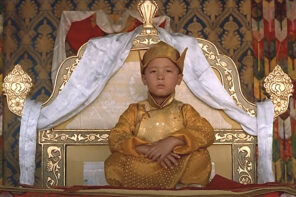Not long ago, researchers wired up the atheist Richard Dawkins with a helmet that would create magnetic fields partially simulating the brain activity of temporal lobe epilepsy, which they linked to dramatic visionary religious experiences and to less dramatic feelings of sensed presences. It turns out, though, that hooking up a hardboiled atheist to a machine, known as the transcranial magnetic stimulator, produced no such experiences. “It was a great disappointment,” Dawkins related after 40 minutes on the machine. “Though I joked about the possibility, I of course never expected to end up believing in anything supernatural. But I did hope to share some of the feelings experienced by religious mystics when contemplating the mysteries of life and the cosmos.”
As my own mind was being massaged with images of Richard Dawkins having his temporal lobes stimulated, an odd notion popped into my head: namely, when it comes to religion, history and culture trump neurology. I quickly noticed that the same neuroscientists who were experimenting on Dawkins, among other more amenable test subjects, were also enfolding American religious history into their neurotheological data. One of the neurologists involved in the Dawkins stunt suggested in an interview, for example, that Ellen G. White, nineteenth-century prophet of the Seventh-day Adventist movement, suffered a childhood head injury that affected her temporal lobes in such a way as to produce her subsequent religious visions.
That example immediately struck me as a curious incursion of history into the laboratory. To be sure, even as an outsider, I was aware that a thriving set of conversations exists on the borders of neuroscience and religion. There are the theological questions, the God-spot questions: can the places of divine-human encounter, or, at least, the places of the felt-experiences of divine-human encounter be scanned and visualized? There are the ethical questions: for example, can the lying brain be mapped, detected, and exposed? Or, can compassionate affects be imaged and reproduced—in effect, is altruism a mental skill that can be trained? There are also, of course, innumerable psychotherapeutic questions; prominent among them is whether prayer and meditation are effective allies in the healing arts and medical sciences. But, here was the prolific visionary, Ellen G. White, suddenly thrust into the speculations of a pediatric neurologist studying temporal lobe epilepsy, all because she had been hit in the face by a rock when she was nine years old. Perhaps there is, indeed, a conversation to be had not only between religion and neuroscience, but also, more specifically, between American religious history and American neuroscience.
By way of proposition and broad outline, I want to suggest three conversational pivots for that kind of discussion:
1) The first is the historical interchange between religion and technology. It is useful, I think, to step aside for a moment from the religion-science nexus and to foreground the religion-technology relationship. The use of MRI brain imaging techniques to study religion displays an exuberant confidence in a new technology’s ability to render the invisible visible, to materialize the spiritual dimensions of human experience, whether as a source of naturalistic explanation or empirical validation. The instrument itself is culturally freighted with metaphysical significance, the power to expose religion as an illusion or, conversely, to manifest its reality. Brain imaging techniques participate in this larger historical framing of technology in those terms. Neurotheology, in other words, is one more species of what we might call techno-theologizing—a phenomenon that has flourished in Western culture, especially since the seventeenth and eighteenth centuries.
Take examples from both sides. The magic lantern was widely used by the end of the eighteenth century and throughout the nineteenth century to produce ghost shows, and one of the prevailing morals of such techno-exhibitions was the ease with which the superstitious were duped. The flickering projection of spirits was an emblem of the benighted credulity of the religious imagination. When presented in this light, magic-lantern shows were a kind of performed skepticism—as Ludwig Feuerbach demonstrated. The technology made visible the illusion of the supernatural, the mechanisms of religious misperception.
On the other side of the aisle, technology was regularly seen as a conduit of empirical proof for divine realities. Was not the telegraph, for example, a herald of spiritualist communication? The Society of Psychical Research, on both sides of the Atlantic, was enamored with the notion that the new auditory technologies could well yield spiritual dividends. When the telephone appeared on the scene, some in the SPR threw themselves behind a new contraption called the “psycho-phone” through which the inventors claimed to be hearing the voices of angels. The psychophone no doubt sounds absurd, but I can’t say that it sounds much more far-fetched than a transcranial magnetic stimulator. Both demonstrate the enduring cultural impulse toward techno-theologizing. However much neuroscientists might want to forswear an interest in the metaphysics of their brain-scanning technology, it is clear that such brain-imaging techniques are inevitably framed by precisely those kinds of religious and cultural debates: is MRI brain imaging finally a technology that reveals absence or one that reveals presence? Is it a mechanism that shows religion to be fully reducible to and determined by biological materiality or is it one that ultimately reveals the God-spot, the hard-wiring of divine-human encounter? Asking those kinds of techno-theological questions has been a recurrent cultural theme since the Enlightenment.
2) The second pivot point is recognizing the way that the nation’s religious history shapes the way the mind has been and continues to be imagined, even in many of the study designs on meditation that emerge among contemporary neuroscientists. As novel as it may sound to be monitoring the brainwaves of Tibetan Buddhist monks in university laboratories, it is certainly not the first time that American psychologists have been drawn to meditation and its salubrious effects. It is in the tradition of Harvard’s William James, pioneering psychologist, psychical researcher, and philosopher of religion, that the current turn to the contemplative mind is best understood. Counter to the popular image of Americans as endlessly enterprising, agitated, and restless—all busy Marthas, no reflective Marys—James discerned a deep mystical cast to the American psyche and pursued that strain with uncommon intellectual devotion. Yet, when it came to what he labeled “methodical meditation,” James saw little of it left among American Christians and turned instead to homegrown practitioners of various mind-over-matter cures. He particularly accented those New Thought metaphysicians who were pushing forward a dialogue with far-flung emissaries of yoga and Buddhist meditation in the wake of the World’s Parliament of Religions, held in Chicago in 1893.
Among James’ favored practitioners of these newly improvised regimens of meditation was Ralph Waldo Trine, a Boston-based reformer with a knack for inspirational writing. In his classic account The Varieties of Religious Experience (1902) James used Trine’s blockbuster, In Tune with the Infinite (1897), as an epitome of the emergent practices of concentration, mental repose, and healthy-mindedness then percolating in New England and elsewhere across the country. Though an unabashed popularizer, Trine was not a light-weight. With an educational pedigree that ran from Knox College to the University of Wisconsin to Johns Hopkins University, he moved easily in Boston’s wider metaphysical circles. In much the same way that current studies promote the clinical applications of meditation, Trine emphasized the healthful benefits that accrued from cultivating a calm yet expectant mind. He had no scanners or electrodes, but he had the same hopes about improving the mental and physical health of Americans through elaborating a universal practice of meditation, one that transcended the particularities of any one religious tradition and represented a kind of essential composite of all faiths. And while Trine did not have the Dalai Lama at hand, as some neuroscientists now do, he did have extended contact with a similarly well-traveled Sinhalese Buddhist monk, Anagarika Dharmapala, with whom he compared notes and devotional habits as he was putting together his own system of meditation for Americans, a practical antidote to American nervousness and the then newly identified disease of neurasthenia.
The real payoff for Trine, it should also be said, was not established through a calculus of productivity or cheerfulness: would encouraging meditation or other visualization techniques make people more alert and proficient at the office or on the playing field? Would it make them feel happier and less disgruntled? Trine, like James and some current neuroscientists, was finally more interested in saintliness and compassion than helping stressed-out brainworkers relax and concentrate. It is hard not to hear a hint of Richard J. Davidson’s pursuit of altruism in Trine’s contemplative emphasis on the “Spirit of Infinite Love.” And it is hard not to see that the world of William James and Ralph Waldo Trine is alive and well as American investigators wire up Buddhist monks in a search for the powers of the concentrated mind, the mental disciplines of harmony, compassion, and peace that might make the world a marginally kinder, less selfish place. That optimism about human nature—that the mind has deep reservoirs of potential for empathy and altruism—had a lot more backing among religious liberals and progressives in 1900 than it does today. Still, the considerable hopes now invested in meditation suggest that the old Jamesian aspirations continue to flourish, especially among members of the mind-preoccupied knowledge class.
3) The third point is how the broader cultural equation of religion with “spirituality,” with “mystical experience,” and with the “search for meaning,” has shaped the research concerns of neuroscience when it turns its attention to religious questions. At least in the popularized image of the intersections of religion and neuroscience that filter out of the laboratory and into, say, Newsweek, the focus seems inevitably to be on “Tibetan monks lost in meditation” or “Franciscan nuns deep in prayer.” Such images of brain imaging convey an essentialized romantic picture of religion as mystical absorption, as immediate personal experience. Despite the institutional and monastic structures that shape the lives of monks and nuns, under the scan of current cultural assumptions, they might as well all be bearers of what William James called “personal religion pure and simple.” In other words, we have in the current popularization of neuroscientific studies of prayer and meditation a near perfect mirroring of James’s definition of religion as “the experiences of individual men in their solitude.”
It is a stretch to say this, but the very image of the MRI scanner appears as a kind of hermit’s cell, a withdrawal into a narrow cave of isolation and bodily stillness. Would anyone ever expect such technology to generate a picture of the devotee’s commitment to ecclesiastical organizations, social solidarities, sacrificial systems, or gendered hierarchies? While this is a technology that James might well celebrate right along with Abraham Maslow, would it be of any use at all to Durkheim or Mary Douglas or Talal Asad? One of Andrew Newberg’s popular books on religion and brain science, for example, carries in its subtitle the equation of religion with “Meaning, Spirituality, and Truth.” We still need the companion volume on power, violence, and the construction of truth, but those brain-science images of religion are going to be a much harder sell in a culture still hungry for William James’s particular variety of religious experience—the joyous expansions of soul, the momentary gifts of intensity and calm repose, the exalted feelings of presence, and the serenity of meditative well-being. William James, a century later, remains a dazzling writer on religion, but I wouldn’t want to build a science of religion—or, a neuroscience of religion—around his fascinations alone.




